Damping Property of Cement Mortar Incorporating Damping Aggregate
Abstract
:1. Introduction
2. Materials and Methods
2.1. Materials
2.2. Preparation of DA
2.3. Mixture Preparation
2.4. Test Methods
2.4.1. Mechanical Properties Test
2.4.2. Damping Property Test
3. Results and Discussion
3.1. Compressive Strength
3.2. Flexural Strength
3.3. Damping Ratio
4. Damping Mechanism
5. Conclusions
- (1)
- The compressive strength of specimens containing 30% DA all retained more than 35 MPa. The addition of fiber had a marginal effect on the compressive strength of the cement mortar, while the flexural strength of specimens approximately increased by 25% when the fiber content beyond 0.5%. Adding rubber powder had a negative effect on the compressive and the flexural strength of the cement mortar, especially when the rubber powder content beyond 2.5%.
- (2)
- The damping ratio of the specimen showed an increasing trend as the percentage of DA increased. The increasing tendency was slight when the percentage of DA below 30%, while a sharp increase of damping ratio could be found at the specimen containing 50% DA. Damping ratio of the specimen containing 70% SEA was approximately three times higher than that of reference mortar. Indicating that the cement mortar incorporating DA can be used to improve the damping property of structures.
- (3)
- The new cement mortar containing the DA developed had a superior damping property compared to that of the normal cement mortar. The addition of fiber or rubber powder can further improve the damping property of the cement mortar. Adding fiber was more effective than rubber powder in improving the damping ratio of the cement mortar, and the optimal dosage of the fiber was 0.5%. The damping ratio of the specimen containing 1.0% fiber reached to 10.7% after 28 days of curing, which was approximately one times higher than that of the cement mortar with 30% SEA, with a slight influence in the mechanical properties.
Author Contributions
Funding
Conflicts of Interest
References
- Parghi, A.; Alam, M.S. A Review On the application of sprayed-FRP composites for strengthening of concrete and masonry structures in the construction sector. Compos. Struct. 2018, 187, 518–534. [Google Scholar] [CrossRef]
- Abed, F.; Alhafiz, A.R. Effect of basalt fibers on the flexural behavior of concrete beams reinforced with bfrp bars. Compos. Struct. 2019, 215, 23–34. [Google Scholar] [CrossRef]
- Niu, D.; Huang, D.; Fu, Q. Experimental investigation on compressive strength and chloride permeability of fiber-reinforced concrete with basalt-polypropylene fibers. Adv. Struct. Eng. 2019, 22, 2278–2288. [Google Scholar] [CrossRef]
- Tahar, Z.; Ngo, T.; Kadri, E.H.; Bouvet, A.; Debieb, F.; Aggoun, S. Effect of cement and admixture on the utilization of recycled aggregates in concrete. Constr. Build. Mater. 2017, 149, 91–102. [Google Scholar] [CrossRef]
- Caetano, H.; Rodrigues, J.P.C.; Pimienta, P. Flexural strength at high temperatures of a high strength steel and polypropylene fibre concrete. Constr. Build. Mater. 2019, 227, 116721. [Google Scholar] [CrossRef]
- Tian, Y.; Shi, S.; Jia, K.; Hu, S. Mechanical and dynamic properties of high strength concrete modified with lightweight aggregates presaturated polymer emulsion. Constr. Build. Mater. 2015, 93, 1151–1156. [Google Scholar] [CrossRef]
- Giner, V.T.; Ivorra, S.; Baeza, F.J.; Zornoza, E.; Ferrer, B. Silica fume admixture effect on the dynamic properties of concrete. Constr. Build. Mater. 2011, 25, 3272–3277. [Google Scholar] [CrossRef]
- Wang, C.; Xiao, J.; Wang, C.; Zhang, C. Nonlinear damping and nonlinear responses of recycled aggregate concrete frames under earthquake loading. Eng. Struct. 2019, 201, 109575. [Google Scholar] [CrossRef]
- Liang, C.; Liu, T.; Xiao, J.; Zou, D.; Yang, Q. The damping property of recycled aggregate concrete. Constr. Build. Mater. 2016, 102, 834–842. [Google Scholar] [CrossRef]
- Long, G.; Yang, J.; Xie, Y. The mechanical characteristics of steam-cured high strength concrete incorporating with lightweight aggregate. Constr. Build. Mater. 2017, 136, 456–464. [Google Scholar] [CrossRef]
- Cortés, F.; Castillo, G. Comparison between the dynamical properties of polymer concrete and grey cast iron for machine tool applications. Mater. Des. 2007, 28, 1461–1466. [Google Scholar] [CrossRef]
- Chi, L.; Lu, S.; Yao, Y. Damping additives used in cement-matrix composites: A review. Compos. Part B Eng. 2019, 164, 26–36. [Google Scholar] [CrossRef]
- Hou, H.; Wang, T.; Wu, S.; Xue, Y.; Tan, R.; Chen, J.; Zhou, M. Investigation on the pavement performance of asphalt mixture based on predicted dynamic modulus. Constr. Build. Mater. 2016, 106, 11–17. [Google Scholar] [CrossRef]
- Leiben, Z.; Wang, X.; Wang, Z.; Yang, B.; Tian, Y.; He, R. Damping characteristics of cement asphalt emulsion mortars. Constr. Build. Mater. 2018, 173, 201–208. [Google Scholar] [CrossRef]
- Lee, K.S.; Choi, J.; Park, S.E.; Hwang, J.; Lee, B.Y. Damping property of prepacked concrete incorporating coarse aggregates coated with polyurethane. Cem. Concr. Compos. 2018, 93, 301–308. [Google Scholar] [CrossRef]
- Fu, Q.; Xie, Y.; Long, G.; Niu, D.; Song, H. Dynamic mechanical thermo-analysis of cement and asphalt mortar. Powder Technol. 2017, 313, 36–43. [Google Scholar] [CrossRef]
- Jeon, E.; Ahn, S.; Lee, I.; Koh, H.; Park, J.; Kim, H. Investigation of mechanical/dynamic properties of carbon fiber reinforced polymer concrete for low noise railway slab. Compos. Struct. 2015, 134, 27–35. [Google Scholar] [CrossRef]
- Akça, K.R.; Çakır, Ö.; İpek, M. Properties of polypropylene fiber reinforced concrete using recycled aggregates. Constr. Build. Mater. 2015, 98, 620–630. [Google Scholar] [CrossRef]
- Li, L.; Poon, C.S.; Xiao, J.; Xuan, D. Effect of carbonated recycled coarse aggregate on the dynamic compressive behavior of recycled aggregate concrete. Constr. Build. Mater. 2017, 151, 52–62. [Google Scholar] [CrossRef]
- Si, R.; Guo, S.; Dai, Q. Durability performance of rubberized mortar and concrete with NaOH-solution treated rubber particles. Constr. Build. Mater. 2017, 153, 496–505. [Google Scholar] [CrossRef]
- Lin, J.; Hong, J.; Xiao, Y. Dynamic characteristics of 100% cold recycled asphalt mixture using asphalt emulsion and cement. J. Clean. Prod. 2017, 156, 337–344. [Google Scholar] [CrossRef]
- Song, W.; Zou, D.; Liu, T.; Teng, J.; Li, L. Effects of recycled CRT glass fine aggregate size and content on mechanical and damping properties of concrete. Constr. Build. Mater. 2019, 202, 332–340. [Google Scholar] [CrossRef]
- Yu, W.; Shao, H.; Cheng, C.; Yueh, L.; Ken, C.; Wu, P.C. Influence of various sodium salt species on formation mechanism of lightweight aggregates made from coal fly ash-based material. Constr. Build. Mater. 2020, 239, 117890. [Google Scholar]
- Abhilash, M.; Jhanjhari, S.; Parthiban, P.; Karthikeyan, J. Axial behaviour of semi-lightweight aggregate concrete-filled steel tube columns—A DOE approach. J. Constr. Steel Res. 2019, 162, 105614. [Google Scholar] [CrossRef]
- Yoon, J.Y.; Kim, J.H. Mechanical properties of preplaced lightweight aggregates concrete. Constr. Build. Mater. 2019, 216, 440–449. [Google Scholar] [CrossRef]
- Common Portland Cement; China Architecture and Building Press: Beijing, China, 2007.
- Sand for Construction; China Architecture and Building Press: Beijing, China, 2011.
- Technical Specification for Application of Lightweight Aggregate Concrete; China Architecture and Building Press: Beijing, China, 2017.
- Standard for Test Method of Performance on Building Mortar; China Architecture and Building Press: Beijing, China, 2009.
- Al-Subaihawi, S.; Kolay, C.; Marullo, T.; Ricles, J.M.; Quiel, S.E. Assessment of wind-induced vibration mitigation in a tall building with damped outriggers using real-time hybrid simulations. Eng. Struct. 2020, 205, 110044. [Google Scholar] [CrossRef]
- Papagiannopoulos, G.A.; Hatzigeorgiou, G.D. On the use of the half-power bandwidth method to estimate damping in building structures. Soil Dyn. Earthq. Eng. 2011, 31, 1075–1079. [Google Scholar] [CrossRef]
- Li, T.; Xiao, J.; Sui, T.; Liang, C.; Li, L. Effect of recycled coarse aggregate to damping variation of concrete. Constr. Build. Mater. 2018, 178, 445–452. [Google Scholar] [CrossRef]
- Bentz, D.P. Influence of internal curing using lightweight aggregates on interfacial transition zone percolation and chloride ingress in mortars. Cem. Concr. Compos. 2009, 31, 285–289. [Google Scholar] [CrossRef]
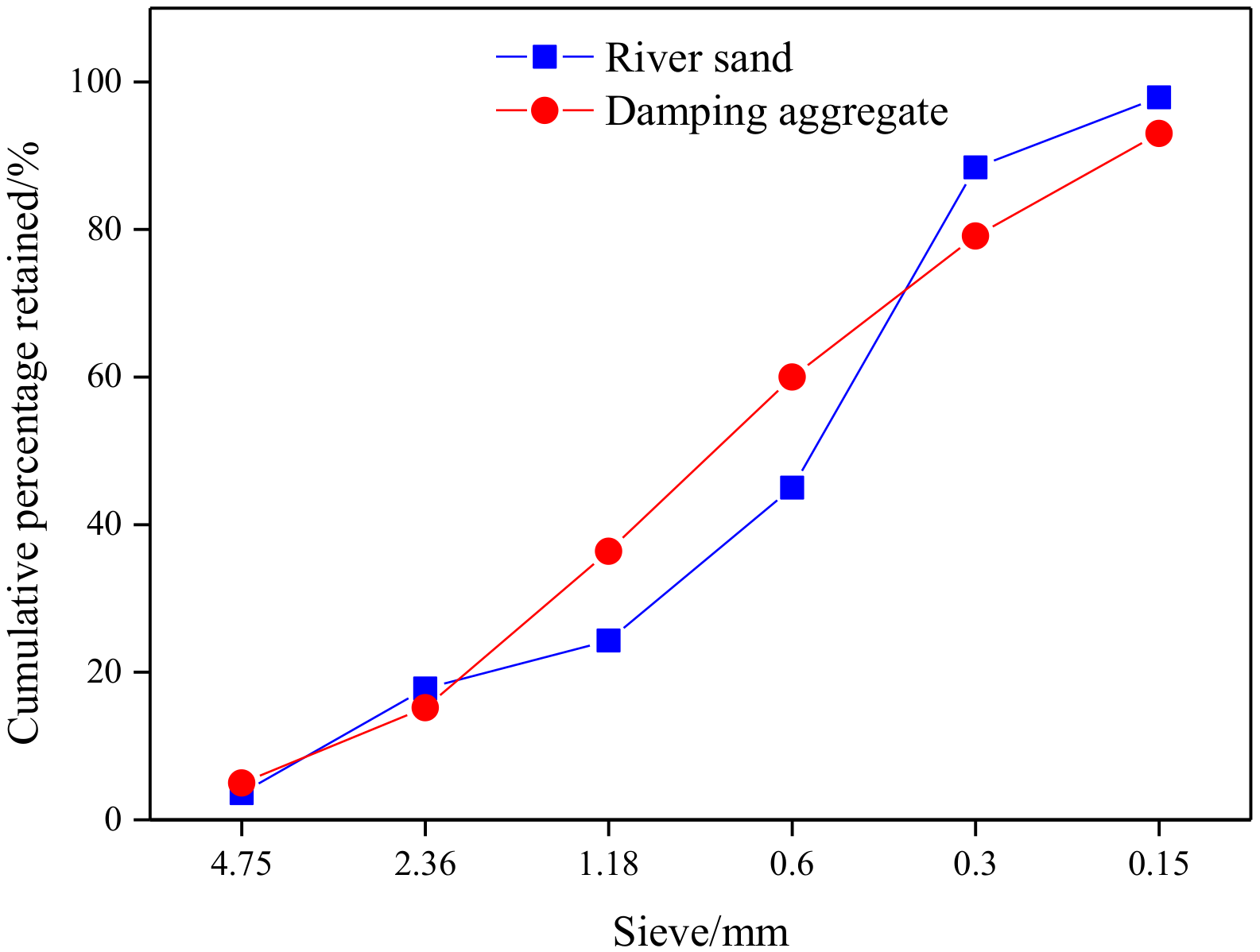
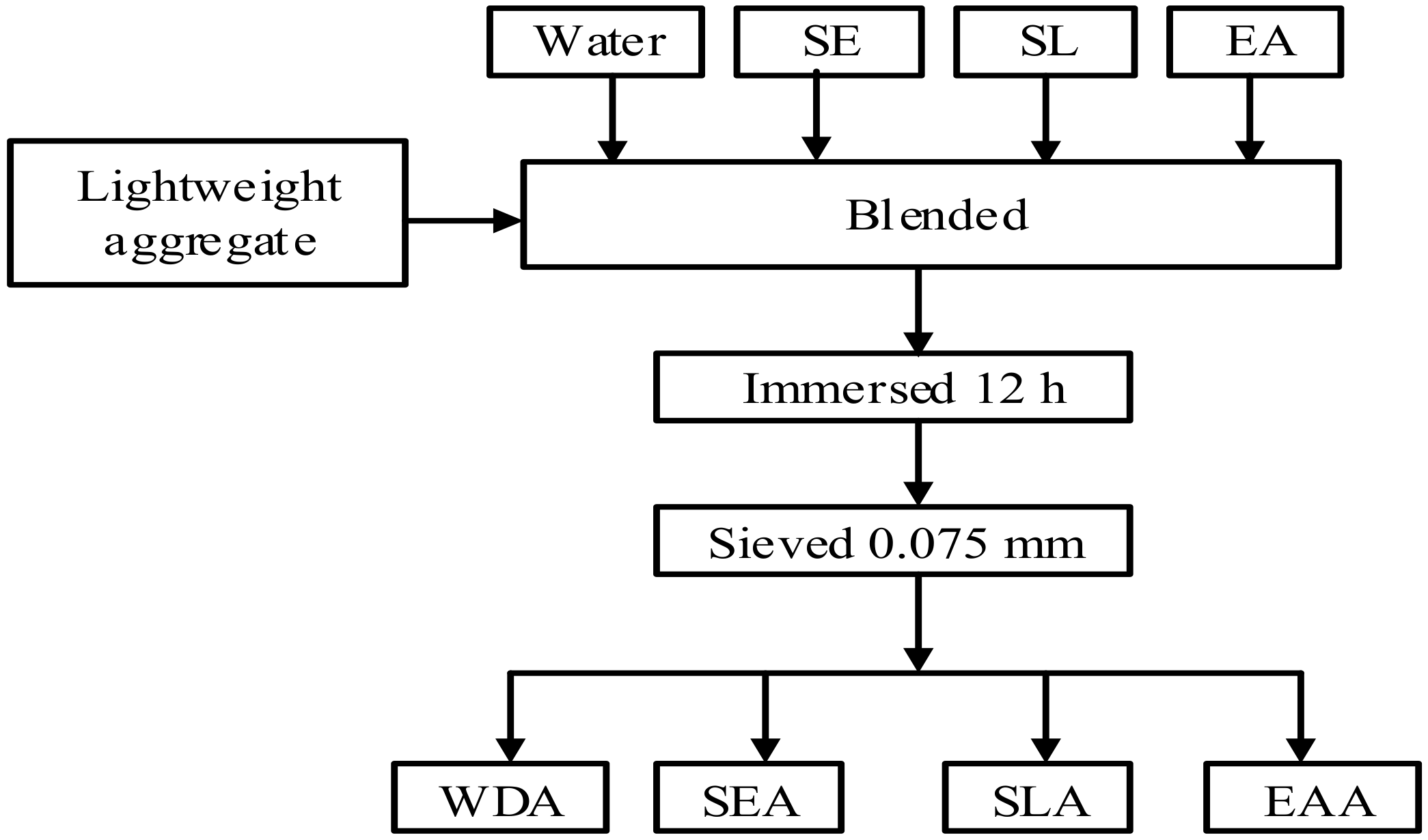

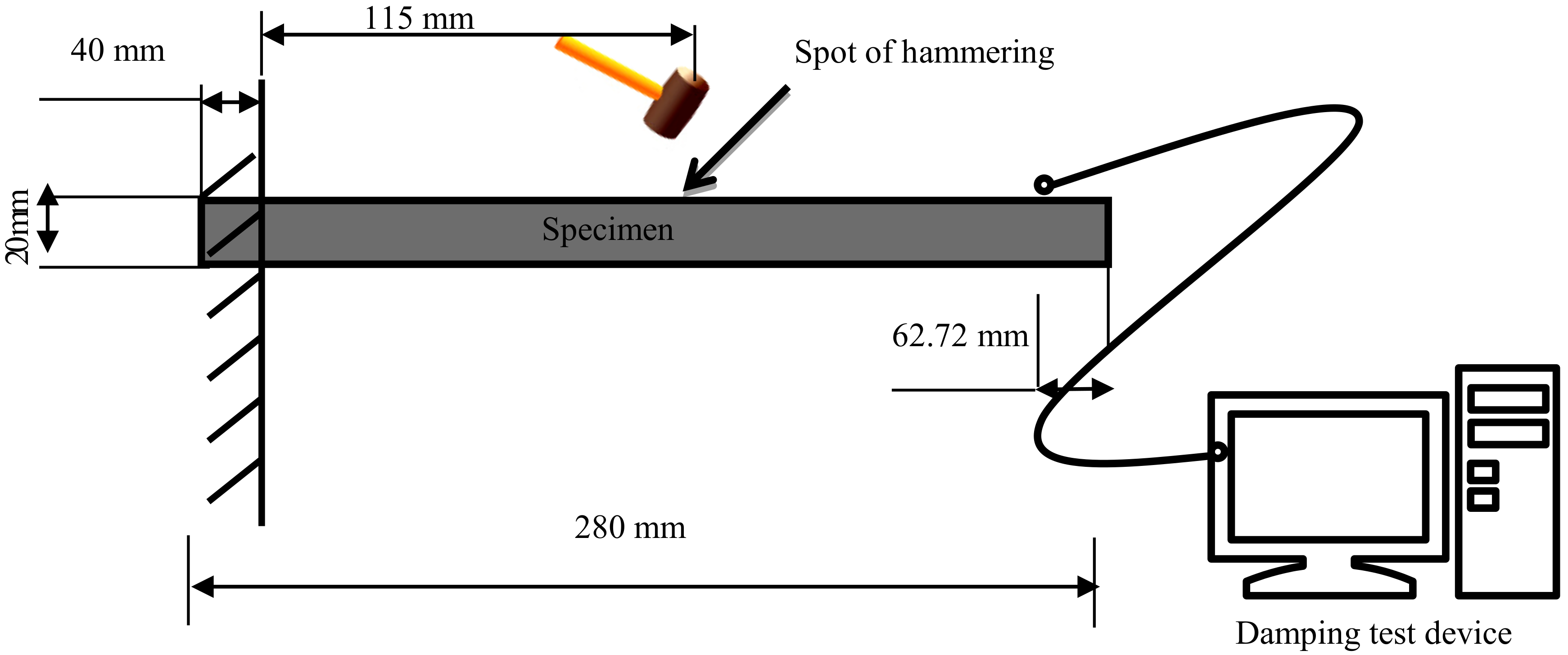
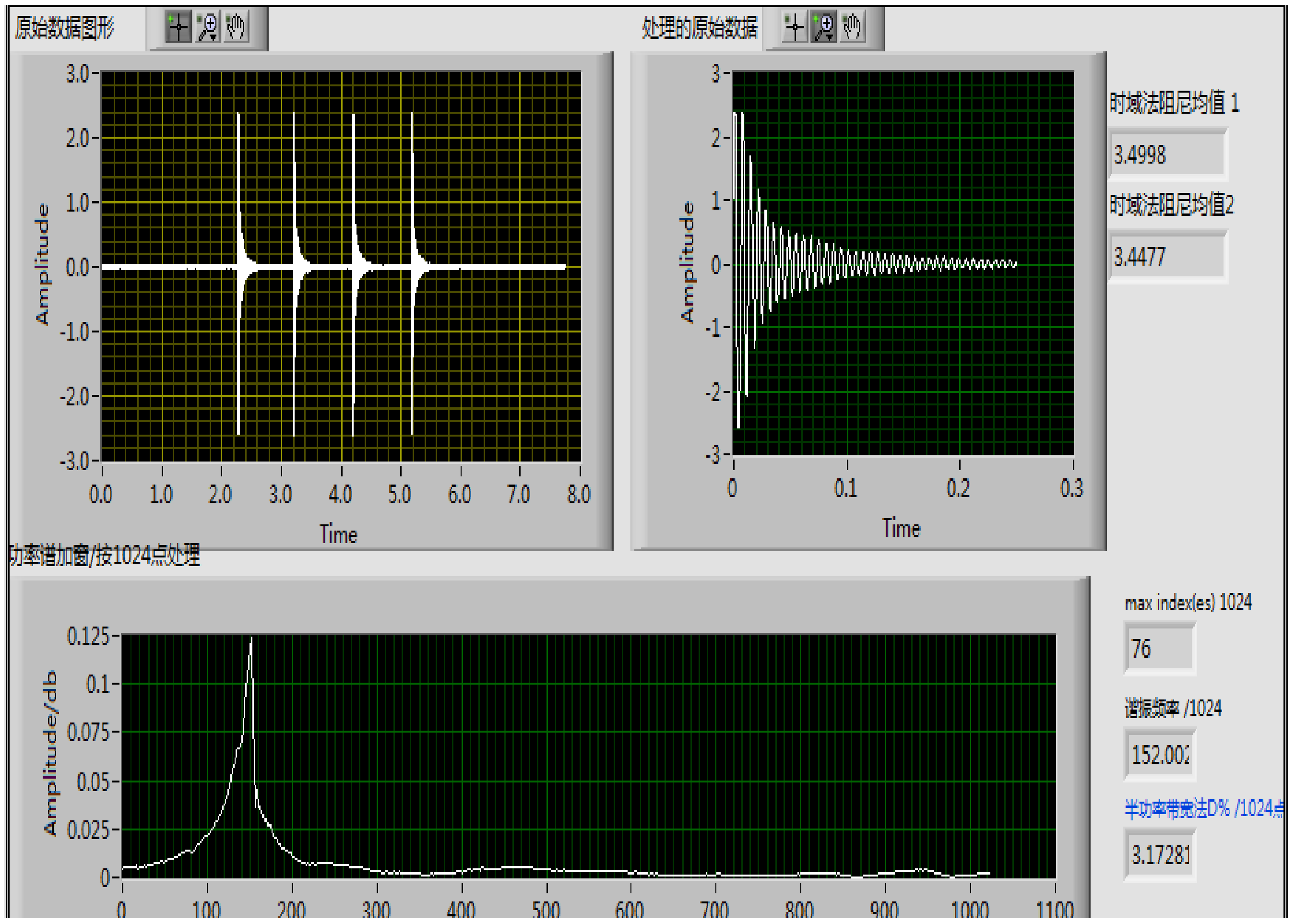
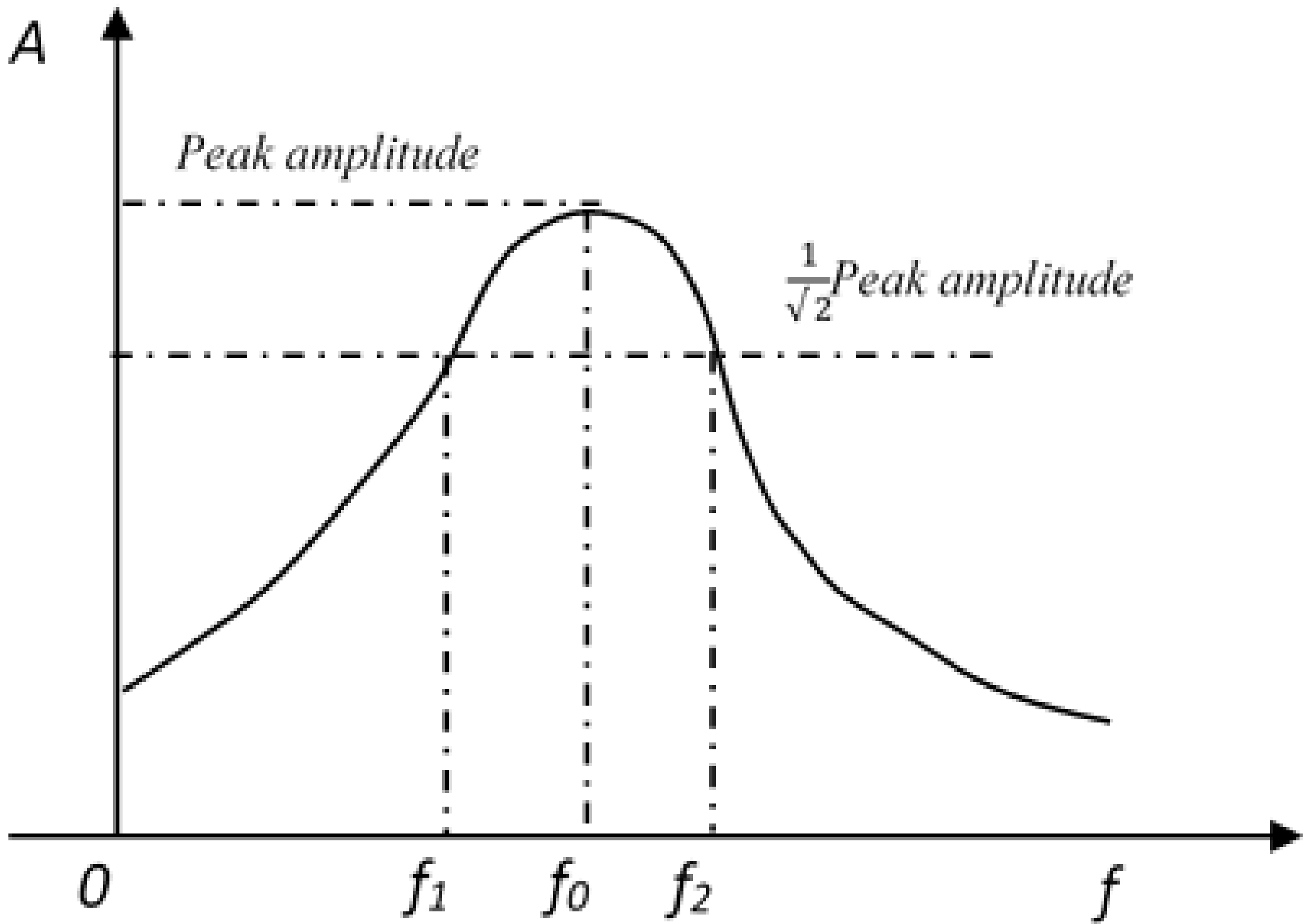
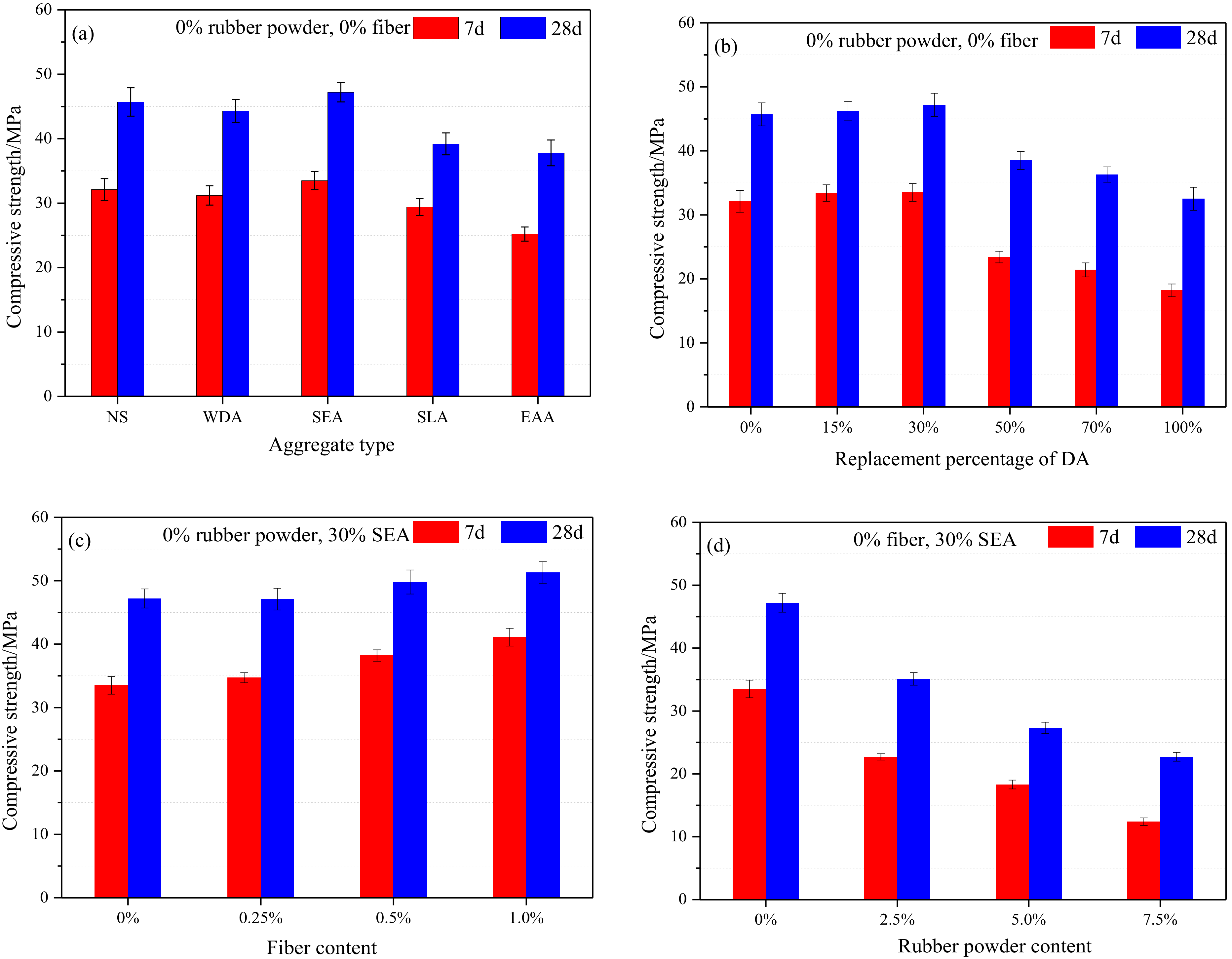
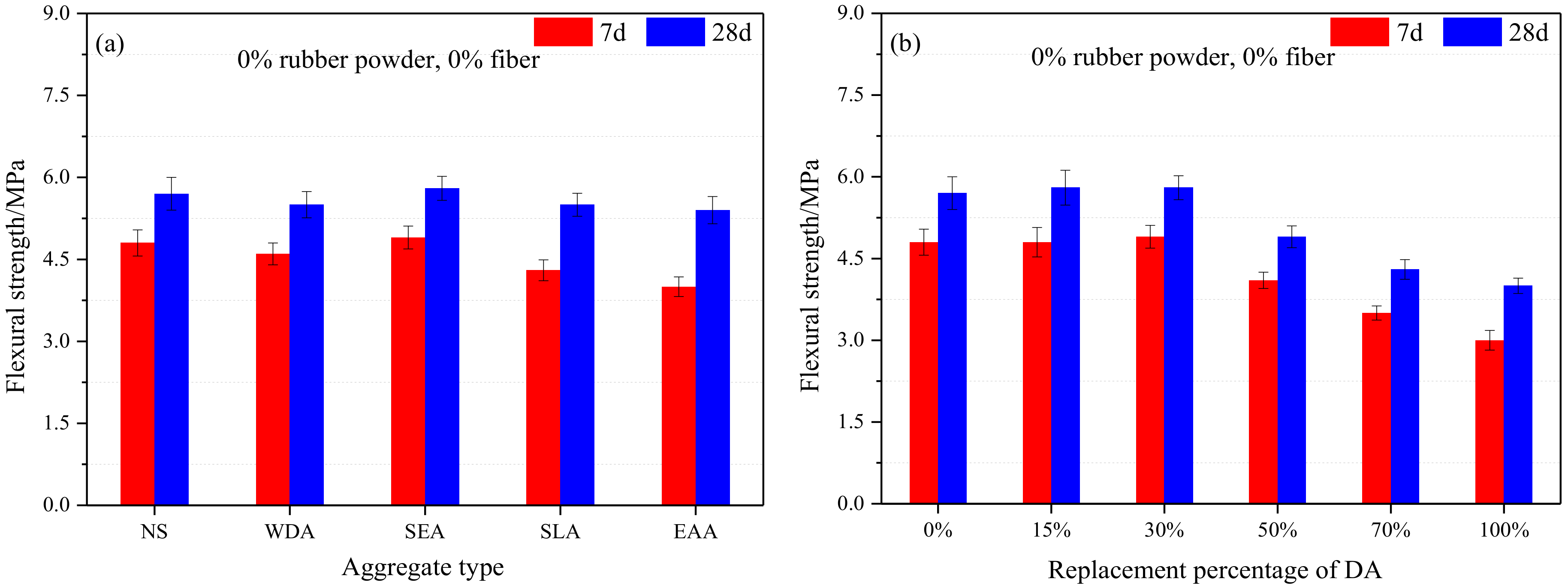
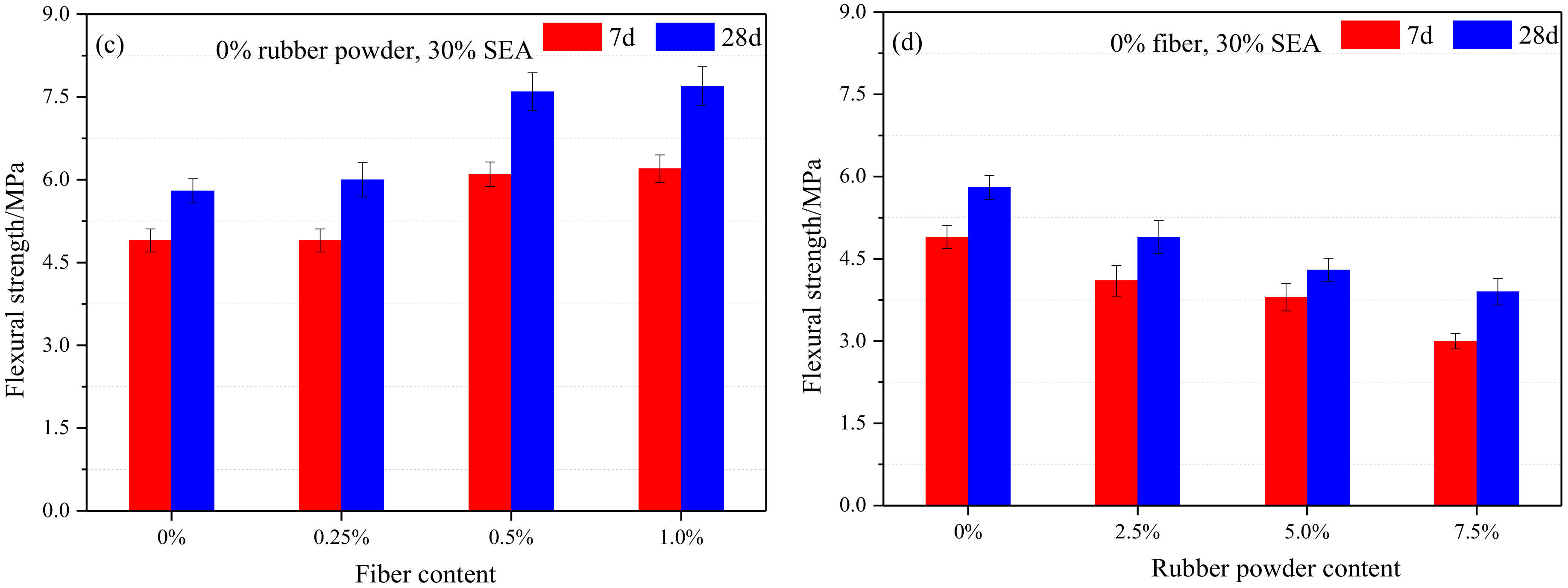
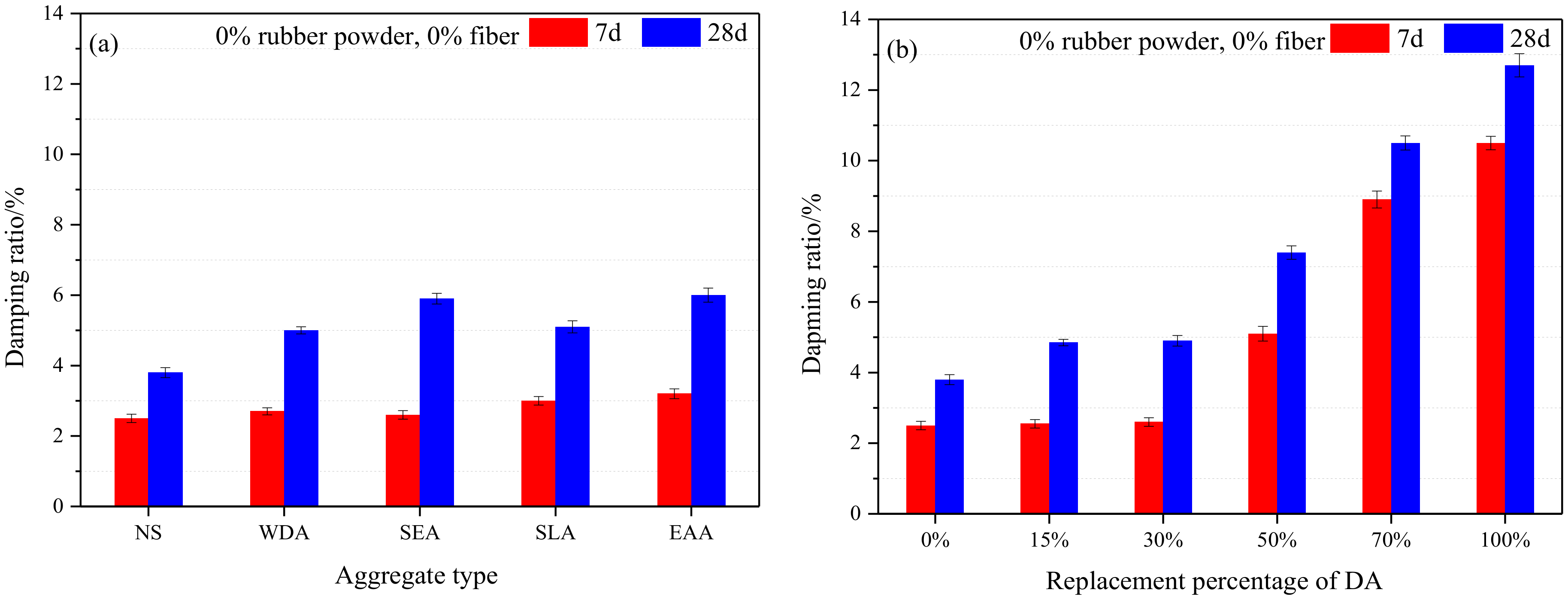
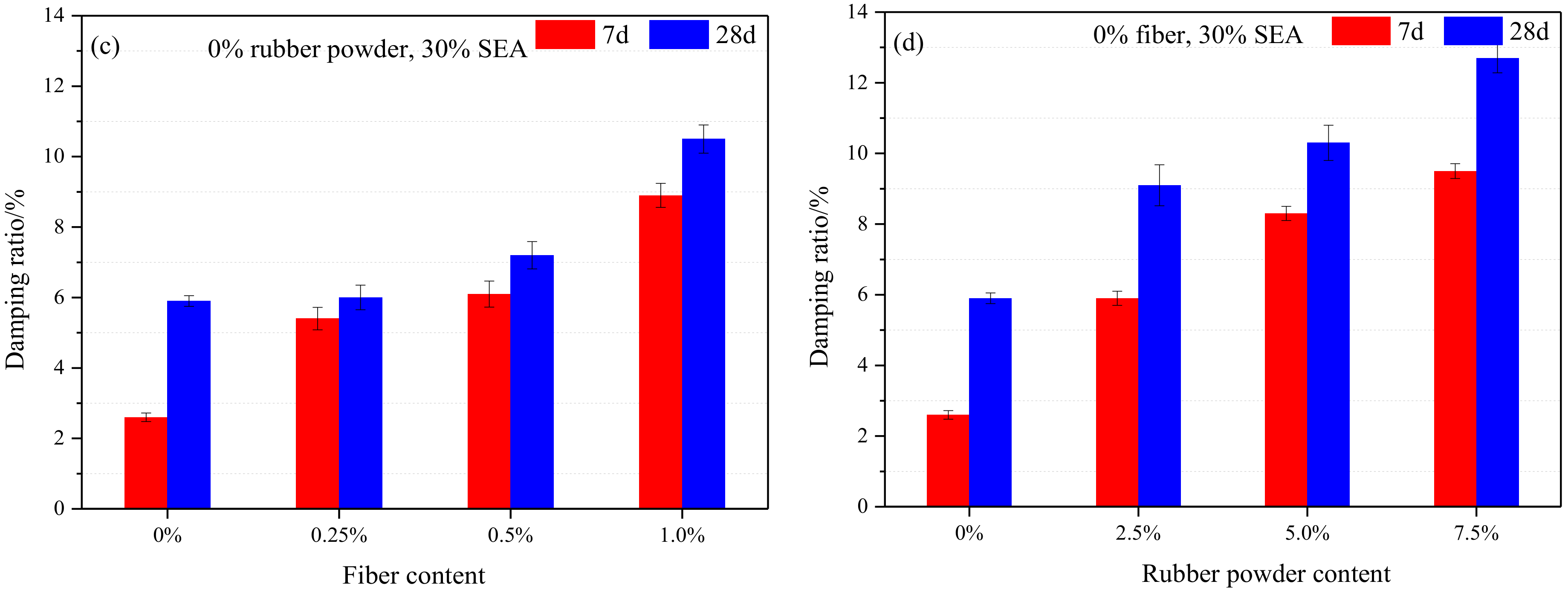
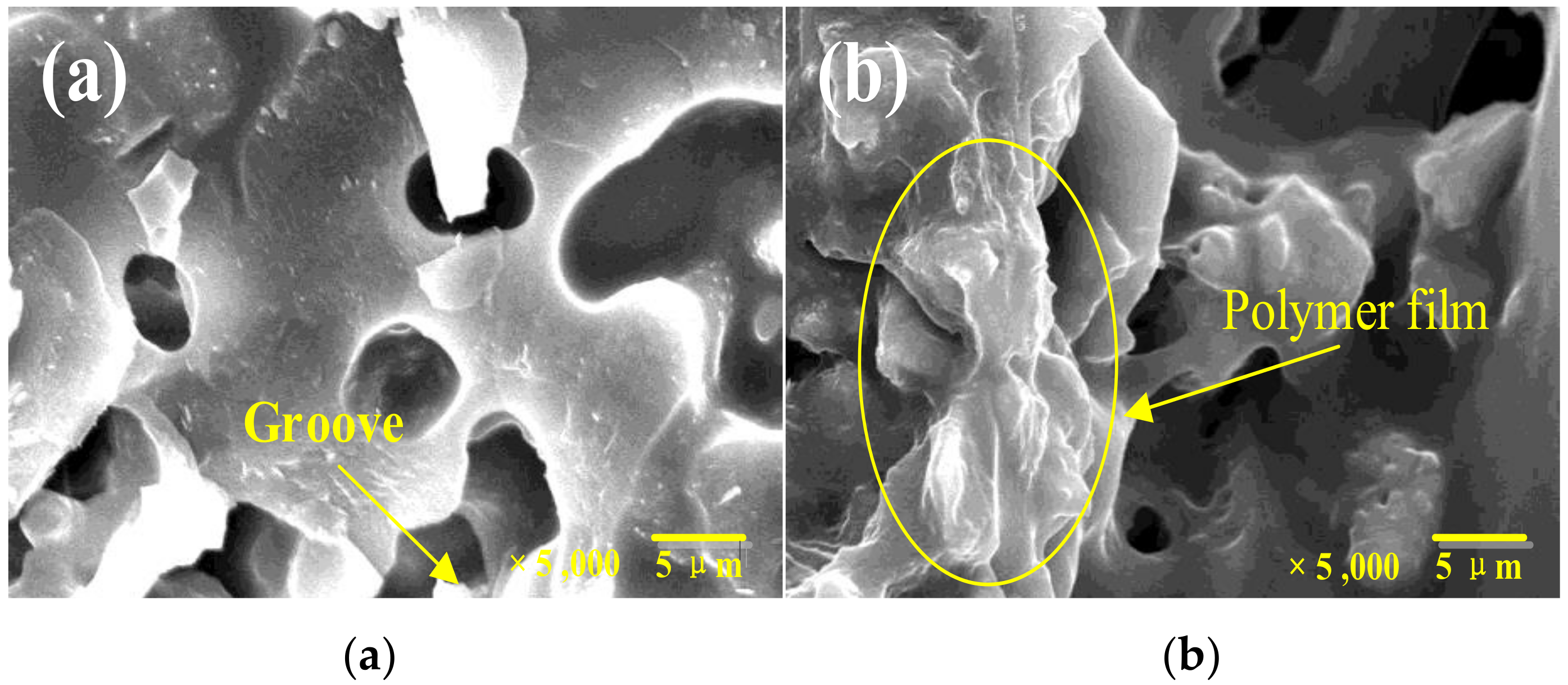
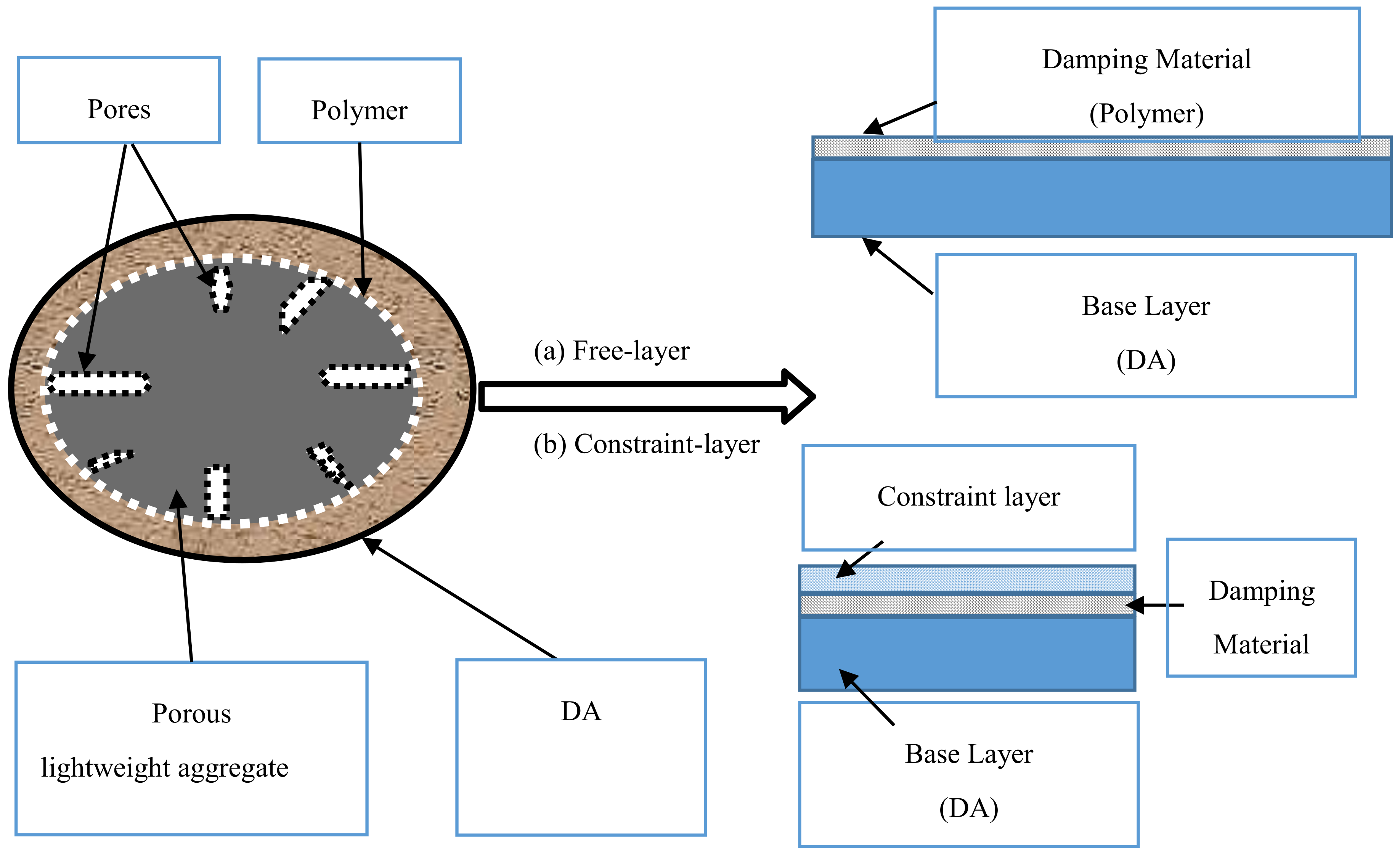
| Mass (wt.%) | Specific Surface Area (m2/kg) | ||||||
|---|---|---|---|---|---|---|---|
| SiO2 | Al2O3 | Fe2O3 | CaO | MgO | SO3 | Loss | |
| 21.38 | 5.74 | 4.01 | 59.79 | 3.47 | 2.11 | 2.68 | 360.00 |
| Crushing Strength (MPa) | Particle Density (g/cm3) | Bulk Density (g/cm3) | Water Absorption (%) | Polymer Emulsion Absorption (%) | ||||
|---|---|---|---|---|---|---|---|---|
| 30 min | 1 h | 24 h | 30 min | 1 h | 24 h | |||
| 2.3 | 1.2 | 0.5 | 4.3 | 5.3 | 5.8 | 0.9 | 1.5 | 2.0 |
| Mix Code | Aggregate | NS | DA | Water | Cement | SP (%) | Fiber (%) | Rubber Powder (%) |
|---|---|---|---|---|---|---|---|---|
| 1 | NS | 1350.0 | 0 | 149.1 | 450 | 0.5 | - | - |
| 2 | SEA | 1147.5 | 202.5 | 149.1 | 450 | 0.5 | - | - |
| 3 | SEA | 945.0 | 405.0 | 149.1 | 450 | 0.5 | - | - |
| 4 | SEA | 675.0 | 675.0 | 149.1 | 450 | 0.5 | - | - |
| 5 | SEA | 405.0 | 945.0 | 149.1 | 450 | 0.5 | - | - |
| 6 | SEA | 0 | 1350.0 | 149.1 | 450 | 0.5 | - | - |
| 7 | SEA | 945.0 | 187.4 | 149.1 | 450 | 0.5 | 0.25 | - |
| 8 | SEA | 945.0 | 187.4 | 149.1 | 450 | 0.5 | 0.50 | - |
| 9 | SEA | 945.0 | 187.4 | 149.1 | 450 | 0.5 | 1.00 | - |
| 10 | SEA | 945.0 | 187.4 | 149.1 | 450 | 0.5 | - | 2.5 |
| 11 | SEA | 945.0 | 187.4 | 149.1 | 450 | 0.5 | - | 5.0 |
| 12 | SEA | 945.0 | 187.4 | 149.1 | 450 | 0.5 | - | 7.5 |
| 13 | WDA | 945.0 | 187.4 | 149.1 | 450 | 0.5 | - | - |
| 14 | SLA | 945.0 | 187.4 | 149.1 | 450 | 0.5 | - | - |
| 15 | EAA | 945.0 | 187.4 | 149.1 | 450 | 0.5 | - | - |
© 2020 by the authors. Licensee MDPI, Basel, Switzerland. This article is an open access article distributed under the terms and conditions of the Creative Commons Attribution (CC BY) license (http://creativecommons.org/licenses/by/4.0/).
Share and Cite
Tian, Y.; Lu, D.; Zhou, J.; Yang, Y.; Wang, Z. Damping Property of Cement Mortar Incorporating Damping Aggregate. Materials 2020, 13, 792. https://doi.org/10.3390/ma13030792
Tian Y, Lu D, Zhou J, Yang Y, Wang Z. Damping Property of Cement Mortar Incorporating Damping Aggregate. Materials. 2020; 13(3):792. https://doi.org/10.3390/ma13030792
Chicago/Turabian StyleTian, Yaogang, Dong Lu, Jianwei Zhou, Yuxuan Yang, and Zhenjun Wang. 2020. "Damping Property of Cement Mortar Incorporating Damping Aggregate" Materials 13, no. 3: 792. https://doi.org/10.3390/ma13030792
APA StyleTian, Y., Lu, D., Zhou, J., Yang, Y., & Wang, Z. (2020). Damping Property of Cement Mortar Incorporating Damping Aggregate. Materials, 13(3), 792. https://doi.org/10.3390/ma13030792





